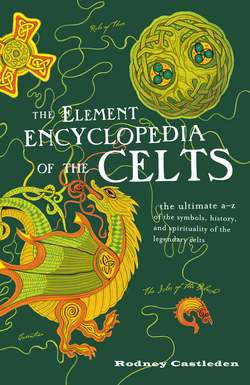Читать книгу The Element Encyclopedia of the Celts - Rodney Castleden - Страница 197
MERLIN
ОглавлениеThe wizard who was King Arthur’s legendary mentor.
It is generally and understandably assumed that Merlin never existed, and he was to an extent an invention of Geoffrey of Monmouth, but the character was based on a collection of old poems, riddles, and triads preserved in Wales but relating to a real sixth-century Celtic bard, or carminator, called Myrddin, the Celtic form of Martin, who lived in the north close to Hadrian’s Wall. The aristocratic Norman-French readers for whom Geoffrey was writing would have pronounced Myrddin Merdin, and probably sniggered at a name so close to merde (= excrement). The Latin form of Myrddin, Merdinus, was no better—merda means “excrement” too, so Geoffrey had little choice but to change it. He chose Merlin.
In the Dark Ages, kings regularly employed bards to compose praise poems, occasional pieces on great victories or disastrous defeats, and funeral odes. The bards memorized their compositions for recitation in the feast halls (See Food and Feasting, Memory). A major role of the bard of the war-band was to entertain the warriors, often with stirring tales of their own great deeds. The impression given by the surviving fragments of Dark Age Celtic poetry is of ceaseless warfare, feasting, drinking, boasting, and showing off. Occasionally, bards confronted warriors with uncomfortable truths, perhaps to shame them into trying harder. In Rheged arise, Taliesin writes, “Not too well did they fight around their king [Urien]: to lie would be wrong.”
Taliesin served at least three and possibly four kings in succession—Cynan of Powys, Urien of Rheged, Gwallawg of Elmet, and Owain of Rheged—and seems always to have had the greater cause of the British—the Cymry, as they called one another—at heart, even if that meant deserting white-haired Urien for the younger Gwallawg. This element of unpredictability is one distinctive trait of the legendary Merlin.
We have no direct evidence of Arthur’s bard, but he too would have had such a figure to sing of his exploits: in part to entertain and in part to condition his companions and warriors to see his as the greatest cause and inspire their unswerving loyalty.
Yet Arthur’s Merlin has been portrayed by tradition as more than a bard. He is a magus. It is often assumed that this is an invention of the high Middle Ages, perhaps specifically an invention by Geoffrey of Monmouth, but there is plenty of evidence that sixth-century kings invariably had spiritual advisers or chaplains at their sides so that supernatural help was always on call. Muirchetach mac Erca, High King of Ireland from 503 onward, was a contemporary of Arthur’s and very much an Arthur-like figure himself. He leaned heavily on a British monk.
Bridei, King of the pagan Picts in the years after Arthur’s death, had a chief magician called Broichan, who also functioned as a foster father and tutor to the king in true Celtic tradition. The relationship between these two real, documented, and truly historical figures is very similar to that described as existing between Arthur and Merlin in the fully developed medieval romances.
Arthur’s “Merlin” may have even been based on a priest-companion. The Dark Age saints were a law unto themselves—wayward, volatile, intensely committed to their mission, fiercely jealous and competitive, and ever on the alert for the voice of God telling them to pack up and move on. This eccentric and unpredictable behavior is very much what we see in Merlin’s character, even to the disappearing and reappearing. One tradition is that St. Piran was Arthur’s chaplain. Another possibility is that Merlin might be loosely based on St. Dubricius: the bishop credited with crowning Arthur.
Whether Arthur had a saint or a wizard at his side is hard to tell. Perhaps one of the things that made him extraordinary in his day was that he kept a wizard even though he was at least a nominal Christian. He may have had a wizard in his entourage to get the other point of view.
